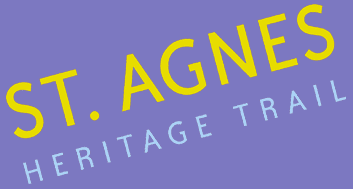
Walk 1 - St.Agnes Village Trail
With Peterville Woods on your left and then the Peterville Inn, you are now entering Peterville, named after the Peter family who once lived here. During its industrial heyday, Peterville was known as Dirtypool because of the dirty pool which formed at its lower end. On the site of Images of Cornwall stood a wheelwright's shop and opposite in what is now Siestas was a single storey forge M. Peterville was obviously a great place for story tellers (and still is!). Gunner Dick's forge (Richard Stephens'), as John Tregellas tells us, "was sufficiently capacious, (besides containing the fire and forge tools, a water trough, used to receive and cool the heated tongs, etc.), to admit of a circular seat sufficient to hold ten or twelve gossips, who, every evening, sat there and enjoyed the heat of the forge, and increased its smoky atmosphere by puffing their short and well-blackened tobacco pipes."
Past the Tap House to the entrance to Wheal Kitty Lane, stands a wooden bench which has long been a similar gathering place for story tellers, one of whom told of a "true" incident where a plague of rats was flushed out of the village. "Rats! Rats? Why, you've never seen rats like it. One of 'em cleared a five bar gate in one bound, and he was carryin' a Alsatian dog in his mouth!" Such were the stories at the old men's bench.
Find British Road and head up to the Cleaderscroft Hotel 200m on the right N. Built in the 19th century, this was the home of the Hancock family who were variously connected with the mining industry. George Coulter Hancock was famous for his no nonsense approach. A note to the milkman next to two jugs (rather than the usual one for the milk to be ladled into) read: "Put the milk in one and the water in the other, we will do our own mixing, thank you." Further up the hill on the right stands Mr. Hancock's coach house, a three-storey building two of which, you will notice, are accessible from ground level. Next door is the old school, the playground now a lawn, its classrooms now apartments O.
The school holds so many voices from the past. The images of the classroom are so readily conjured. In his office, the head master is writing in the school log book:
24.12.1895 - This school is re-opened today after the long closing because of diphtheria. Mistress absent through illness. School carried on by Pupil teachers.
21.4.1896 Object Lessons - Revision of the Whale, the Cat, the Camel and the Elephant.
1.5.1896 - Taught the children a new action rhyme 'Sing a Song of Sixpence'. Hark - can you hear them?
 By walking up one of the lanes beside the school you will see, set behind it, the St. Agnes Coastguard headquarters with its fine bay window on the first floor; beyond lie the Coastguard Houses. This is private property. Built in the 1890s and with a telephone connection to the lookout on the coast, the rocket apparatus with its breeches buoy could be made ready at a moments notice should a ship run aground P. Two days after Christmas 1900, the clipper Seine was wrecked at Perranporth where the local team failed to get a line to the stranded crew. A poem excerpt tells more. (St. Anns is the local pronunciation of St. Agnes where 'g' is silent!).
By walking up one of the lanes beside the school you will see, set behind it, the St. Agnes Coastguard headquarters with its fine bay window on the first floor; beyond lie the Coastguard Houses. This is private property. Built in the 1890s and with a telephone connection to the lookout on the coast, the rocket apparatus with its breeches buoy could be made ready at a moments notice should a ship run aground P. Two days after Christmas 1900, the clipper Seine was wrecked at Perranporth where the local team failed to get a line to the stranded crew. A poem excerpt tells more. (St. Anns is the local pronunciation of St. Agnes where 'g' is silent!).
As soon as St. Anns gear was fixed,
The elevating done,
The rocket flew with the small line,
St. Anns was number one.
 Walk 1 - St.Agnes Village Trail
Walk 1 - St.Agnes Village Trail Walk 2 - St Agnes Beacon
Walk 2 - St Agnes Beacon Walk 3 - Porthtowan, Banns Vale, Mount Hawke and Chapel Porth
Walk 3 - Porthtowan, Banns Vale, Mount Hawke and Chapel Porth Walk 4 - Wheal Rose, The Poldice Plateway and Mawla
Walk 4 - Wheal Rose, The Poldice Plateway and Mawla Walk 5 - Mount Hawke
Walk 5 - Mount Hawke Walk 6 - Mithian
Walk 6 - Mithian Walk 7 - Wheal Coates, Chapel Porth, Wheal Lawrence Valley and Goonvrea
Walk 7 - Wheal Coates, Chapel Porth, Wheal Lawrence Valley and Goonvrea Walk 8 - Water Lane, Wheal Butson and Jericho Valley
Walk 8 - Water Lane, Wheal Butson and Jericho Valley Walk 9 - Jericho Valley and Cross Coombe
Walk 9 - Jericho Valley and Cross Coombe Walk 10 - Blackwater
Walk 10 - Blackwater
